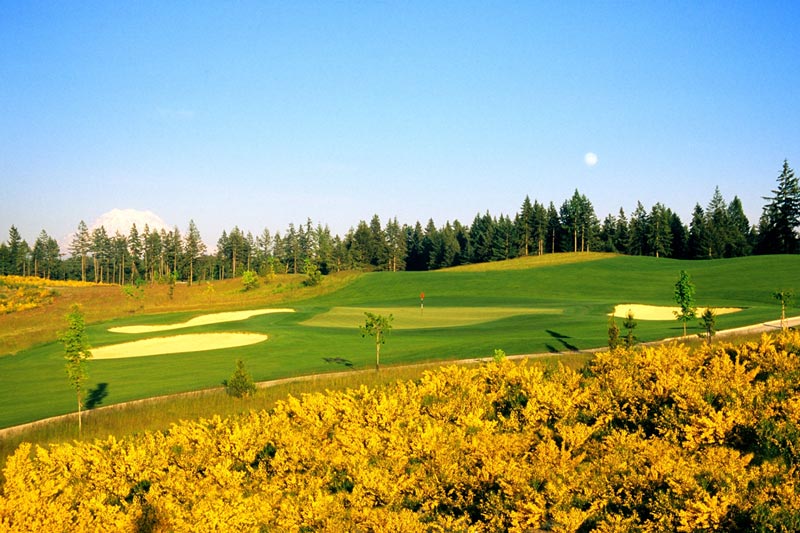
In a past life, the grounds of The Home Course in DuPont, Wash., housed a plant that produced dynamite and black powder. The unique track — the sixth hole is shown here — will host stroke play for this month’s U.S. Amateur Four-Ball Championship. Photo courtesy of The Home Course
The Home Course in DuPont, Wash., was once the site of a plant that produced and manufactured commercial explosives. The USGA seems to think the public golf course that now sits on the land is dynamite.
The sixth U.S. Amateur Four-Ball Championship is May 22-26, and The Home Course will be a part of the action, serving as a co-host to stroke play rounds with Chambers Bay in University Place, Wash. The Home Course, designed by the late architect Mike Asmundson, served as a U.S. Open local qualifying site for the championship held in 2015 at Chambers Bay. Before that, The Home Course was the companion course for the U.S. Amateur in 2010 at Chambers Bay.
Championships are often reserved for older, more famous facilities, yet the 14-year-old Home Course is establishing an impressive résumé. It’s cooperatively owned by the Pacific Northwest Golf Association and Washington Golf. Both organizations plan to eventually house their offices on the scenic layout between Puget Sound, Mount Rainier and the Olympic Mountains. GCSAA Class A superintendent Dennis Roque, a 17-year GCSAA member, oversees The Home Course.
“Dennis is going to do a great job,” says Cory Isom, USGA Green Section West Region agronomist. “Someone like him makes it easier for us to achieve what championship directors are looking for.”
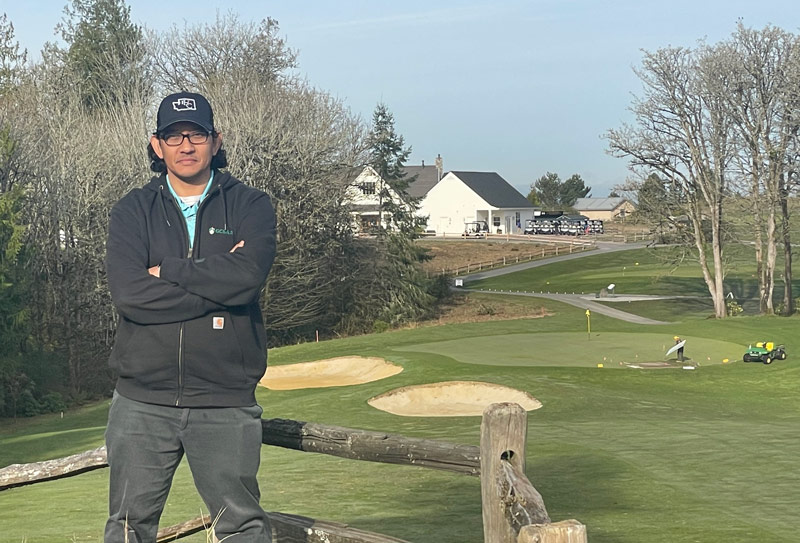
GCSAA Class A superintendent Dennis Roque has worked at The Home Course since 2008 and took the reins as superintendent in 2014. Photo courtesy of Dennis Roque
Unless you’re from the area, you may not know the entire, fascinating story that literally lies beneath, in and around The Home Course. The land was originally settled by multiple Native American tribes, including the Nisqually Tribe. Europeans came next. The Hudson’s Bay Co. operated a trading post there. Eventually, E.I. du Pont de Nemours and Co. (now known as DuPont Co.) acquired the property in 1906, and its explosives plant was instrumental in western expansion. Black powder and dynamite were used to help clear the land for farming and railroads. Some rail remains on the golf course today.
The land’s transformation from explosives facility to golf course began to take shape in the late 1970s, when Weyerhaeuser Co. took over the location with the intention of industrializing it. Weyerhaeuser, DuPont and the Washington State Department of Ecology collaborated to launch a site cleanup with cooperation from the Washington State Department of Archaeology and Historical Preservation, the Nisqually Tribe, the city of DuPont, the DuPont Historical Society, and other stakeholders.
Golf course construction was part of the meticulous, thorough environmental remediation process. More than 50,000 cubic yards of contaminated soil — the majority of it the result of explosive compounds — was removed from the site and sent to a hazardous waste landfill.
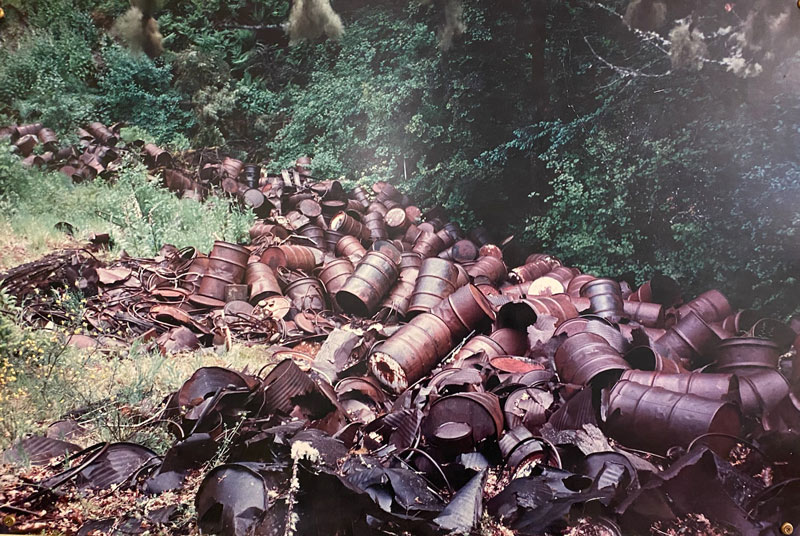
The contents of these barrels that were removed from the site before the golf course was constructed remains a mystery. “No one really knows what was in those barrels — at least not us anyway,” says Home Course superintendent Dennis Roque. “It could not have been good.” Photo courtesy of Dennis Roque
“Before the cleanup, it was a pretty gnarly joint,” says Home Course equipment manager Joey Bass, a seven-year GCSAA member who has been familiar with the property since before the golf course was initially seeded. Bass recalls workers wearing Tyvek protective suits to safeguard from hazardous materials.
A photo gallery on the state’s Department of Ecology website has a hole-by-hole breakdown of what was addressed during the massive cleanup effort. Here’s a sampling:
- No. 4 has a natural topographical depression, which was used as a disposal area for empty drums. The back tee is bordered by the foundation from a former manufacturing building.
- No. 7 is the spot to be on a sunny day, as it offers quite a view of Mount Rainier. It’s also where the site cleanup identified lead and other materials of concern.
- No. 16 is an ideal place to take in Puget Sound. It’s also where a former explosives storage area was incorporated into the golf course design, resulting in a distinct mound.
The history makes for some unconventional maintenance challenges for Roque and his crew. “Essentially, it (the course) was capped and grown on gravel,” he says. “That makes trying to grow grass pretty difficult.” The Home Course has T-1 bentgrass greens; the rest of the layout is a ryegrass/Poa annua mix. Roque says his biggest issue with the grass is that everything leaches, and holding nutrients is difficult. His method of offsetting the gravel in order to secure soil nutrients is by sanding tees and fairways (80/20 sand/organic matter). “Pretty extensive sanding, twice a year,” Roque says of the work done on tees, fairways and surrounds. “We bring in close to 270 tons of sand.”
Roque can’t easily aerify tees and fairways, despite years of sanding. He has tried solid tines and tines bent 90 degrees. “It’s not too tough trying to solid-tine (tees), but pulling up a core is tough. You can bring up a lot of gravel,” he says. “The most I can do is slice the fairways with a Bannerman, using an 8-inch blade. You’re able to slice the fairways, but aerifying is not in the cards yet.”
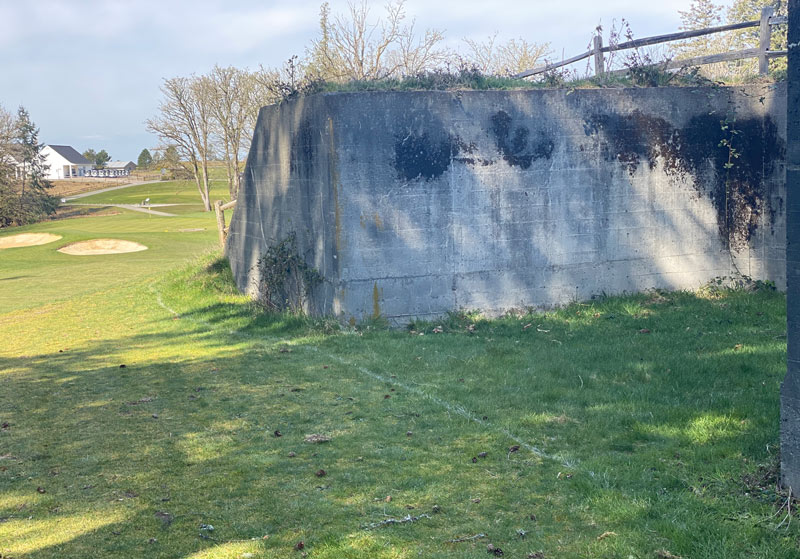
This part of an old storage bunker — which were referred to as “concrete magazines” — is located to the left of the ninth hole rough. Superintendent Dennis Roque says the feature comes into play quite often.
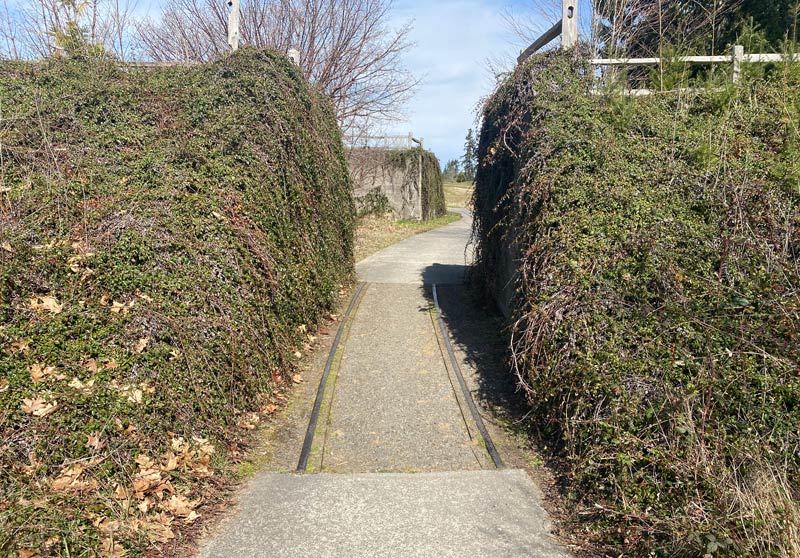
Railroad tracks to the left of the No. 10 tee. “This railway took supplies or workers to all parts of the property,” says Home Course superintendent Dennis Roque. “This short piece of track is all that remains of the railway. You have to pass through it to get to the white and blue tees on No. 10.” Photos courtesy of Dennis Roque
Five years ago, the Washington State Department of Ecology announced The Home Course had been removed from the Hazardous Sites List, formally recognizing an effective cleanup.
Oh, traces of the bygone era remain. Bricks that were removed from a power station on the land have been installed between some tee boxes. If a golfer pipes a drive on the 15th tee to the right side of the large fairway mound that has remnants from the explosives manufacturing area buried beneath it, the result can be a hefty bounce that advances the ball even farther.
The Home Course has certainly come a long way. “They’ve taken it and made it better,” says former DuPont Mayor Michael Grayum. “Dennis and his staff are top-notch. Having the USGA come is icing on the cake.”
Allyson Brooks, Ph.D., director/officer for the Washington State Department of Archaeology and Historical Preservation, says, “It’s an interesting place for a golf course. It has such a wealth of history.”
Roque was introduced to the industry as a caretaker of research plots at Washington State University. Later, he arrived as an assistant at The Home Course in 2008, where he was mentored by then-superintendent Kelly Donaldson. In 2014, Roque became superintendent. He tells a story about a former maintenance employee who swears he saw a ghost on the first hole several years ago. Initially, Roque was skeptical. Now? Not so much. “Since I got here 13 years ago and began to delve into the history, I’m not completely surprised,” he says.
Although he hasn’t seen a ghost himself, Roque does sense the presence of something truly special with the USGA championship happening soon. And he’s having an absolute blast. “Coming off a crazy year, this is huge,” Roque says. “The grind is hard, but it’s worth it. It definitely has become quite the place here.”
Howard Richman is GCM’s associate editor.